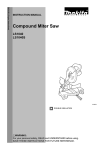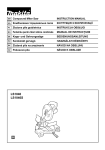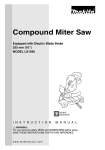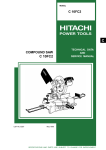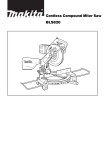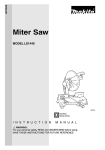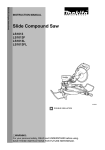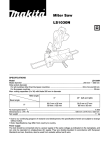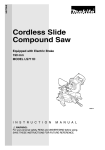Download Makita LS1040S Specifications
Transcript
Compound Miter Saw LS1040 DOUBLE INSULATION SPECIFICATIONS Model LS1040 Blade diameter .................................................................................................................................. 255 mm — 260 mm Hole (arbor) diameter For all countries other than European countries .......................................................................... 25.4 mm and 25 mm For European countries ...................................................................................................................................... 30 mm Max. cutting capacities (H x W) with blade 260 mm in diameter Miter angle 0° 45° (left and right) 0° 93 mm x 95 mm 69 mm x 135 mm 93 mm x 67 mm 69 mm x 95 mm 45° (left) 53 mm x 95 mm 35 mm x 135 mm 49 mm x 67 mm 35 mm x 94 mm Bevel angle No load speed (min–1) ............................................................................................................................................ 4,600 Dimensions (L x W x H) ..................................................................................................... 530 mm x 476 mm x 532 mm Net weight ...............................................................................................................................................................11 kg • Due to our continuing program of research and development, the specifications herein are subject to change without notice. • Note: Specifications may differ from country to country. Intended use The tool is intended for accurate straight and miter cutting in wood. With appropriate saw blades, aluminum can also be sawed. Power supply The tool should be connected only to a power supply of the same voltage as indicated on the nameplate, and can only be operated on single-phase AC supply. They are double-insulated in accordance with European Standard and can, therefore, also be used from sockets without earth wire. For public low-voltage distribution systems of between 220 V and 250 V Switching operations of electric apparatus cause voltage fluctuations. The operation of this device under unfavorable mains conditions can have adverse effects to the operation of other equipment. With a mains impedance equal or less than 0.30 Ohms it can be presumed that there will be no negative effects. The mains socket used for this device must be protected with a fuse or protective circuit breaker having slow tripping characteristics. For European countries only Noise and Vibration The typical A-weighted noise levels are sound pressure level: 93 dB (A) sound power level: 106dB (A) – Wear ear protection. – The typical weighted root mean square acceleration value is not more than 2.5 m/s2. EC-DECLARATION OF CONFORMITY We declare under our sole responsibility that this product is in compliance with the following standards or standardized documents, EN61029, EN55014, EN61000 in accordance with Council Directives, 73/23/EEC, 89/336/EEC and 98/37/EC. Yasuhiko Kanzaki CE 97 Director MAKITA INTERNATIONAL EUROPE LTD. Michigan Drive, Tongwell, Milton Keynes, Bucks MK15 8JD, ENGLAND 2 1 2 1 3 2 3 1 5 2 4 3 4 6 9 7 8 7 5 6 11 12 15 13 14 10 13 17 18 16 7 8 3 9 19 20 9 10 22 21 23 11 12 24 26 25 13 14 29 27 28 15 4 16 30 7 29 17 18 31 34 32 33 135 mm 19 20 19 35 9 36 35 37 21 22 38 41 42 39 27 43 40 23 27 24 5 45 44 9 25 26 47 48 50 46 48 49 27 28 51 52 29 30 53 40 54 55 56 31 6 57 58 90 mm 25 mm 90 mm 107 mm 107 mm 90 mm 59 59 32 62 60 40 34 61 46 33 34 64 (4) (3) (2) (1) 35 65 63 35 36 68 13 62 35 66 37 67 36 37 38 7 69 39 70 71 40 Symbols The following show the symbols used for the tool. Be sure that you understand their meaning before use. ❏ Read instruction manual. ❏ DOUBLE INSULATION 8 ENGLISH Explanation of general view 1 2 3 4 5 6 7 8 9 10 11 12 13 14 15 16 17 18 19 20 21 22 23 24 Base Hex bolt Auxiliary plate Nut Bolt Center cover Socket wrench Shaft lock Loosen Arrow Blade case Arrow Saw blade Spindle Flange Ring Flange Hex bolt Tighten Safety cover Dust spout Dust bag Fastener Lock-off button 25 26 27 28 29 30 31 32 33 34 35 36 37 38 39 40 41 42 43 44 45 46 47 48 Switch trigger Lever Turn base Kerf board Sub-fence Adjusting bolt Pointer Miter scale Latch spring Grip Lever Bevel scale Pointer Vise rod Screws Guide fence Vise arm Clamp screw Support Knob Projection Holder Screw Holder assembly SAFETY INSTRUCTIONS Warning! When using electric tools, basic safety precautions should always be followed to reduce the risk of fire, electric shock and personal injury, including the following. Read all these instructions before attempting to operate this product and save these instructions. 9. 10. 11. For safe operation: 1. Keep work area clean Cluttered areas and benches invite injuries. 2. 3. 4. 5. 6. 7. 8. Consider work area environment Don’t expose power tools to rain. Don’t use power tools in damp or wet locations. Keep work area well lit. Don’t use power tools in presence of flammable liquids or gases. Guard against electric shock Prevent body contact with grounded surfaces (e.g. pipes, radiators, ranges, refrigerators). Keep children away Do not let visitors contact tool or extension cord. All visitors should be kept away from work area. Store idle tools When not in use, tools should be stored in dry, high, or locked-up place, out of the reach of children. Don’t force tool It will do the job better and safer at the rate for which it was intended. Use right tool Don’t force small tools or attachments to do the job of a heavy duty tool. Don’t use tools for purposes not intended; for example, don’t use circular saw for cutting tree limbs or logs. Dress properly Do not wear loose clothing or jewellery. They can be caught in moving parts. Rubber gloves and non-skid footwear are recommended when working outdoors. Wear protective hair covering to contain long hair. 12. 13. 14. 15. 16. 17. 18. 49 50 51 52 53 54 55 56 57 58 59 60 61 62 63 64 65 66 67 68 69 70 71 Screw Rod 12 Cutting line Groove Vise Spacer block Aluminum extrusion Spacer block Over 10 mm Over 460 mm Hole Set plate Screw Triangular rule Hex bolts Arm Hex bolt (A) Top surface of turn base Arm holder Hex bolt (B) Limit mark Screwdriver Brush holder cap Use safety glasses and hearing protection Also use face or dust mask if cutting operation is dusty. Connect dust extraction equipment If devices are provided for the connection of dust extraction and collection facilities, ensure these are connected and properly used. Don’t abuse cord Never carry tool by cord or yank it to disconnect it from receptacle. Keep cord from heat, oil and sharp edges. Secure work Use clamps or a vice to hold work. It’s safer than using your hand and it frees both hands to operate tool. Don’t overreach Keep proper footing and balance at all times. Maintain tools with care Keep tools sharp and clean for better and safer performance. Follow instructions for lubricating and changing accessories. Inspect tool cords periodically and, if damaged, have repaired by authorised service facility. Inspect extension cords periodically and replace if damaged. Keep handles dry, clean and free from oil and grease. Disconnect tools When not in use, before servicing, and when changing accessories such as blades, bits and cutters. Remove adjusting keys and wrenches Form the habit of checking to see that keys and adjusting wrenches are removed from tool before turning it on. Avoid unintentional starting Don’t carry plugged-in tool with finger on switch. Be sure switch is off when plugging in. Outdoor use extension cords When tool is used outdoors, use only extension cords intended for use outdoors and so marked. 9 19. Stay alert Watch what you are doing. Use common sense. Do not operate tool when you are tired. 20. Check damaged parts Before further use of the tool, a guard or other part that is damaged should be carefully checked to determine that it will operate properly and perform its intended function. Check for alignment of moving parts, binding of moving parts, breakage of parts, mounting, and any other conditions that may affect its operation. A guard or other part that is damaged should be properly repaired or replaced by an authorised service centre unless otherwise indicated elsewhere in this instruction manual. Have defective switches replaced by and authorised service centre. Do not use tool if switch does not turn it on and off. 21. Warning The use of any other accessory or attachment other than recommended in this operating instruction or the catalogue may present a risk of personal injury. 22. Have your tool repaired by an expert This electric appliance is in accordance with the relevant safety rules. Repairing of electric appliances may be carried out only by experts otherwise it may cause considerable danger for the user. ADDITIONAL SAFETY RULES 1. 2. 3. 4. 5. 6. 7. 8. 9. 10. 11. 12. 13. 10 Wear eye protection. Do not operate saw without guards in place. Don’t use the tool in the presence of flammable liquids or gases. Check the blade carefully for cracks or damage before operation. Replace cracked or damaged blade immediately. Use only flanges specified for this tool. Be careful not to damage the arbor, flanges (especially the installing surface) or bolt. Damage to these parts could result in blade breakage. Make sure that the turn base is properly secured so it will not move during operation. For your safety, remove the chips, small pieces, etc. from the table top before operation. Avoid cutting nails. Inspect for and remove all nails from the workpiece before operation. Make sure the shaft lock is released before the switch is turned on. Be sure that the blade does not contact the turn base in the lowest position. Hold the handle firmly. Be aware that the saw moves up or down slightly during start-up and stopping. Do not perform any operation freehand. The workpiece must be secured firmly against the turn base and guide fence with the vise during all operations. Never use your hand to secure the workpiece. 14. Keep hands out of path of saw blade. Avoid contact with any coasting blade. It can still cause severe injury. 15. Never reach around saw blade. 16. Make sure the blade is not contacting the workpiece before the switch is turned on. 17. Before using the tool on an actual workpiece, let it run for a while. Watch for vibration or wobbling that could indicate poor installation or a poorly balanced blade. 18. Wait until the blade attains full speed before cutting. 19. Stop operation immediately if you notice anything abnormal. 20. Do not attempt to lock the trigger in the ON position. 21. Shut off power and wait for saw blade to stop before servicing or adjusting tool. 22. Be alert at all times, especially during repetitive, monotonous operations. Don’t be lulled into a false sense of security. Blades are extremely unforgiving. 23. Always use accessories recommended in this manual. Use of improper accessories such as abrasive wheels may cause an injury. 24. Don’t abuse cord. Never yank cord to disconnect it from the receptacle. Keep cord away from heat, oil, water and sharp edges. 25. Do not use the saw to cut other than aluminum, wood or similar materials. 26. Connect compound miter saws to a dust collecting device when sawing. 27. Select saw blades in relation to the material to be cut. 28. Take care when slotting. 29. Replace the kerf board when worn. SAVE THESE INSTRUCTIONS. OPERATING INSTRUCTIONS Carrying tool (Fig. 1) When carrying the tool, lower the handle fully and press the stopper pin to lock the handle in the lowered position. Secure the turn base by means of the grip. The tool can then be conveniently carried by the carrying grip. WARNING: • Be sure that the tool is unplugged first. • Stopper pin is for carrying purposes only and not for any cutting operations. Installing auxiliary plate (Fig. 2 & 3) Install the auxiliary plate using the notch in the tool’s base and secure it by tightening the hex bolt. Bench mounting saw (Fig. 4) This tool should be bolted with two bolts to a level and stable surface using the bolt holes provided in the tool’s base. This will help prevent tipping and possible injury. Installing or removing saw blade Switch action Important: Always be sure that the tool is switched off and unplugged before installing or removing the blade. CAUTION: • Before plugging in the tool, always check to see that the switch trigger actuates properly and returns to the “OFF” position when released. • When not using the tool, remove the lock-off button and store it in a secure place. This prevents unauthorized operation. • Do not pull the trigger hard without pressing in the lockoff button. This can cause breakage of the switch. To remove the blade, use the socket wrench to loosen the hex bolt holding the center cover by turning it more than three turns counterclockwise. Raise the safety cover and center cover. (Fig. 5) Press the shaft lock so that the blade cannot revolve and use the socket wrench to loosen the hex bolt clockwise. Then remove the hex bolt, outer flange and blade. (Fig. 6) To install the blade, mount it onto the spindle, making sure that the direction of the arrow on the surface of the blade matches the direction of the arrow on the blade case. (Fig. 7) For all countries other than European countries (Fig. 13) To prevent the trigger from being accidentally pulled, a lock-off button is provided. To start the tool, press in the lock-off button and pull the trigger. Release the trigger to stop. CAUTION: • For all countries other than European countries (Fig. 8) The silver ring 25.4 mm in outer diameter is factoryinstalled onto the spindle. The black ring 25 mm in outer diameter is included as standard equipment. Before mounting the blade onto the spindle, always be sure that the correct ring for the arbor hole of the blade you intend to use is installed onto the spindle. • For European countries (Fig. 8) The ring 30 mm in outer diameter is factory-installed onto the spindle. For European countries (Fig. 14) To prevent the trigger from being accidentally pulled, a lock-off button is provided. To start the tool, push the lever to the left, press in the lock-off button and then pull the trigger. Release the trigger to stop. Install the flange and hex bolt, and then use the socket wrench to tighten the hex bolt securely counterclockwise while pressing the shaft lock. Then tighten the hex bolt clockwise to secure the center cover. (Fig. 9) Sub-fence (Fig. 16 & 17) CAUTION: Use only the Makita socket wrench provided to install or remove the blade. Failure to do so may result in overtightening or insufficient tightening of the hex bolt. This could cause an injury. Safety cover (Fig. 10) When lowering the handle, the safety cover rises automatically. The cover returns to its original position when the cut is completed and the handle is raised. NEVER DEFEAT OR REMOVE THE SAFETY COVER. In the interest of your personal safety, always maintain the safety cover in good condition. Any irregular operation of the safety cover should be corrected immediately. NEVER USE THE TOOL WITH A FAULTY SAFETY COVER. If the see-through safety cover becomes dirty, or sawdust adheres to it in such a way that the blade and/ or workpiece is no longer easily visible, unplug the saw and clean the cover carefully with a damp cloth. Do not use solvents or any petroleum-based cleaners on the plastic cover. Dust bag (Fig. 11 & 12) The use of the dust bag makes cutting operations clean and dust collection easy. To attach the dust bag, fit the bag’s entry port over the dust spout. When the dust bag is about half full, remove the dust bag from the tool and pull the fastener out. Empty the dust bag of its contents, tapping it lightly so as to remove particles adhering to the insides which might hamper further collection. Kerf board (Fig. 15) This tool is provided with the kerf board in the turn base. If the kerf groove has not yet been cut in the kerf board by the factory, you should cut the groove before actually using the tool to cut a workpiece. Switch on the tool and lower the blade gently to cut a groove in the kerf board. This tool is equipped with the sub-fence which should ordinarily be positioned as shown in Fig. 16. However, when performing left bevel cuts, set it to the left position as shown in Fig. 17. Maintaining maximum cutting capacity (Fig. 18 & 19) Unplug the tool before any adjustment is attempted. This tool is factory adjusted to provide the max. cutting capacity for a 260 mm saw blade. When the diameter of the blade has been reduced due to sharpening, adjust the depth adjusting bolt by turning it with the socket wrench. The saw blade is lowered by turning the depth adjusting bolt counterclockwise and raised by turning it clockwise. Adjust so that when the handle is in the fully lowered position, there will be a distance of about 135 mm from the front face of the guide fence to the point where the front edge of the blade enters the kerf. With the tool unplugged, rotate the blade by hand while holding the handle all the way down. Be sure that the blade does not contact any part of the lower base when the handle is lowered completely. Positioning for adjusting the miter angle (Fig. 20) Loosen the grip by turning counterclockwise. Turn the turn base while pressing down the latch spring. When you have moved the grip to the position where the pointer indicates the desired angle on the miter scale, securely tighten the grip clockwise. CAUTION: When turning the turn base, be sure to raise the handle fully. 11 Positioning for adjusting the bevel angle (Fig. 21 & 22) The saw blade tilts up to 45° to the left only when the sub-fence is set to the left position as shown in Fig. 17. To adjust the bevel angle, loosen the lever at the rear of the tool. Tilt the blade to the left so that the pointer indicates the desired angle on the bevel scale. Then tighten the lever firmly to secure the arm. CAUTION: When tilting the saw blade, be sure to raise the handle fully. Securing workpiece WARNING: It is extremely important to always secure the workpiece properly and tightly with the vise. Failure to do so can cause the tool to be damaged and/or the workpiece to be destroyed. PERSONAL INJURY MAY ALSO RESULT. Also, after a cutting operation, DO NOT raise the blade until the blade has come to a complete stop. 1. Vertical vise (Fig. 23 & 27) The vertical vise can be installed on the guide fence or the holder assembly (optional accessory). Insert the vise rod into the hole in the guide fence or the holder assembly and tighten the screw to secure the vise rod. Position the vise arm according to the thickness and shape of the workpiece and secure the vise arm by tightening the screw. Press the workpiece flat against the guide fence and the turn base. Position the workpiece at the desired cutting position and secure it firmly by tightening the clamp screw. CAUTION: The workpiece must be secured firmly against the turn base and guide fence with the vise during all operations. If some part contacts the vise, re-position the vise arm. Press the workpiece flat against the guide fence and the turn base. Position the workpiece at the desired cutting position and secure it firmly by tightening the clamp screw of the vise. 2. 12 CAUTION: When cutting long workpieces, use supports that are as high as the top surface level of the turn base. (Fig. 24) Horizontal vise (optional accessory) (Fig. 25 & 26) The horizontal vise can be installed on either the left or right side of the base. When performing 15° or greater miter cuts, install the horizontal vise on the side opposite the direction in which the turn table is to be turned. By turning the knob on the vise counterclockwise, the screw is released and the vise shaft can be moved rapidly in and out. By turning the knob clockwise, the screw remains secured. To grip workpieces, turn the knob gently clockwise until the projection reaches its topmost position, then fasten securely. If the knob is forced in or pulled out while being turned clockwise, the projection may stop at an angle. In this case, turn the knob back counterclockwise until the screw is released, before turning again gently clockwise. 3. Holders and holder assembly (optional accessories) The holders and the holder assembly can be installed on either side as a convenient means of supporting workpieces horizontally. Install them as shown in Fig. 27. Then tighten the screws firmly to secure the holders and the holder assembly. (Fig. 27) When cutting long workpieces, use the holder-rod assembly (optional accessory). It consists of two holder assemblies and two rods 12. (Fig. 28) CAUTION: Always support long workpieces level with the top surface of the turn base for accurate cuts and to prevent dangerous loss of control of the tool. Operation CAUTION: • Before use, be sure to release the handle from the lowered position by pulling the stopper pin. • Make sure the blade is not contacting the workpiece, etc. before the switch is turned on. • Do not apply excessive pressure on the handle when cutting. Too much force may result in overload of the motor and/or decreased cutting efficiency. • Gently press down the handle to perform the cut. If the handle is pressed down with force or if lateral force is applied, the blade will vibrate and leave a mark (saw mark) in the workpiece and the precision of the cut will be impaired. When cutting with this tool, the thickness of the blade is cut out of the workpiece as well. Therefore, your cutting line should be on either the left or right side of the groove in the kerf board. Switch on the tool and wait until the blade attains full speed before lowering gently into the cut. When the blade contacts the workpiece, gradually bear down on the handle to perform the cut. When the cut is completed, switch off the tool and WAIT UNTIL THE BLADE HAS COME TO A COMPLETE STOP before returning the blade to its fully elevated position. A thin piece of cut off material could otherwise contact the coasting blade and be thrown around dangerously. (Fig. 29) 1. Miter cutting Refer to the previously covered “Positioning for adjusting the miter angle”. 2. Bevel cut (Fig. 30) • Left 0° – 45° bevel cuts can be performed. • Set the sub-fence to the left position as shown in Fig. 17. Loosen the lever and tilt the saw blade to set the bevel angle. Be sure to retighten the lever firmly to secure the selected bevel angle safely. Secure the workpiece with the vise. Switch on the tool and wait until the blade attains full speed. Then gently lower the handle to the fully lowered position while applying pressure in parallel with the blade. When the cut is completed, switch off the tool and WAIT UNTIL THE BLADE HAS COME TO A COMPLETE STOP before returning the blade to its fully elevated position. 3. 4. 5. 6. CAUTION: • When performing the bevel cut with the workpiece secured on the left side of the turn base, it will create a condition where the piece cut off will come to rest on the blade. If the blade is raised while the blade is still rotating, this piece may be caught in the blade, causing fragments to be scattered around which is dangerous. The blade should be gently raised only after the blade has come to a complete stop. • When pressing down the handle, apply pressure in parallel with the blade. If a force is applied perpendicularly to the turn base or if the pressure direction is changed during a cut, the precision of the cut will be impaired. • Always set the sub-fence to the left position as shown in Fig. 17 when performing bevel cuts. Compound cutting Compound cutting can be performed at angle shown in the table below. MAINTENANCE CAUTION: Always be sure that the tool is switched off and unplugged before carrying out any work on the tool. Adjusting the cutting angle This tool is carefully adjusted and aligned at the factory, but rough handling may have affected the alignment. If your tool is not aligned properly, perform the following: 1) Miter angle (Fig. 34 & 35) Loosen the grip and set the turn base at zero degrees by turning the turn base. Tighten the grip securely and loosen the hex bolts on the guide fence. Square the side of the blade with the face of the guide fence using a triangular rule, try-square, etc. by moving the right side of the guide fence. Then securely tighten the hex bolts on the guide fence in the order indicated in Fig. 35. 2) Bevel angle When performing the compound cutting, refer to “Miter cutting” and “Bevel cut” explanations. Cutting aluminum extrusion (Fig. 31) When securing aluminum extrusions, use spacer blocks or pieces of scrap as shown in Fig. 31 to prevent deformation of the aluminum. Use a cutting lubricant when cutting the aluminum extrusion to prevent build-up of the aluminum material on the blade. i) 0° bevel angle Loosen the lever at the rear of the tool. Loosen the hex nut and turn the hex bolt (A) two or three revolutions clockwise so that the blade tilts to the right. (Fig. 36) Lower the handle fully and square the side of the blade with the top surface of the turn base using the triangular rule, try-square, etc. by turning the hex bolt (A) counterclockwise. Then tighten the hex nut to secure the hex bolt (A). (Fig. 37) Make sure that the pointer on the arm indicates 0° on the bevel scale on the arm holder. If the pointer does not indicate 0°, loosen the screw securing the pointer and adjust the pointer. (Fig. 38) CAUTION: Never attempt to cut thick or round aluminum extrusions. Thick aluminum extrusions may come loose during operation and round aluminum extrusions cannot be secured firmly with this tool. Wood facing (Fig. 32) Use of wood facing helps to assure splinter-free cuts in workpieces. Attach a wood facing to the guide fence using the holes in the guide fence. ii) 45° bevel angle Adjust 45° bevel angle only after performing 0° bevel angle adjustment. To adjust 45° bevel angle, loosen the lever and tilt the saw blade to the left fully. Make sure that the pointer on the arm indicates 45° on the bevel scale on the arm holder. If the pointer does not indicate 45°, turn the hex bolt (B) on the side of the arm until the pointer indicates 45°. (Fig. 38) Bevel angle Miter angle 45° Left and right 0° – 45° CAUTION: • Use straight wood of even thickness as the wood facing. • See Fig. 32 concerning the dimensions for a suggested wood facing. Cutting repetitive lengths (Fig. 33) When cutting several pieces of stock to the same length, ranging from 240 mm to 400 mm, use of the set plate (optional accessory) will facilitate more efficient operation. Install the set plate on the holder as shown in Fig. 33. Align the cutting line on your workpiece with either the left or right side of the groove in the kerf board, and while holding the workpiece from moving, move the set plate flush against the end of the workpiece. Then secure the set plate with the screw. When the set plate is not used, loosen the screw and turn the set plate out of the way. Replacement of carbon brushes (Fig. 39 & 40) Replace carbon brushes when they are worn down to the limit mark. Both identical carbon brushes should be replaced at the same time. To maintain product safety and reliability, repairs, maintenance or adjustment should be carried out by a Makita Authorized Service Center. 13 ACCESSORIES CAUTION: These accessories or attachments are recommended for use with your Makita tool specified in this manual. The use of any other accessories or attachments might present a risk of injury to persons. The accessories or attachments should be used only in the proper and intended manner. • Dust bag • Set plate • Socket wrench 13 • Holder-rod assembly • Triangular rule • Cross-cut saw blade • Lock-off button • Carbide-tipped saw blade 14 • Holder set • Holder assembly • Auxiliary plate • Horizontal vise • Vertical vise 15 Makita Corporation Japan 884085A228
















